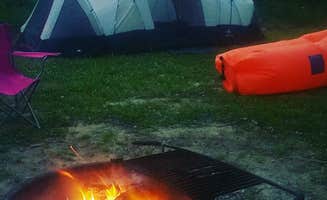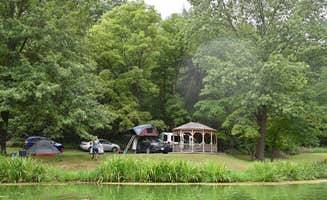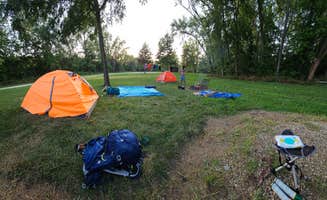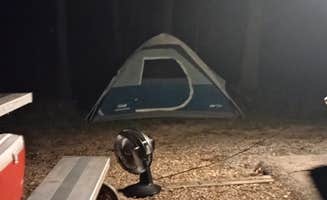Tent campsites near Foristell, Missouri sit in the eastern Missouri landscape where elevations range from 600 to 850 feet above sea level. The area experiences humid continental climate with hot summers and mild winters, making April through October the most popular camping months. Summer temperatures regularly exceed 90°F with high humidity, so campers should plan accordingly with proper hydration and cooling strategies.
What to do
Mountain biking trails: Klondike Park features technical mountain bike sections within the park boundaries. "There are several technical mountain bike sections that are located in the park. Bring your mountain bike and have a go!" notes Mike L. who frequently stays at Klondike Park.
Hiking with elevation changes: Indian Camp Creek Park offers trails with variety for different skill levels. Dr. Edmund A. Babler Memorial State Park also has hiking options that can be challenging for some visitors. "The trails are not too long but can be challenging for small kids or folks that are not used to hiking," explains Scott M. from his visit to Babler State Park.
Fishing opportunities: William R. Logan Conservation Area provides fishing access at multiple stocked lakes. "Plenty of tent spots with tree cover and fire pits. Lighting bugs came out at night," reports Kelly C. who enjoyed the basic but functional camping at Logan Wildlife Area.
What campers like
Hammocking options: Sites 24-25 at Klondike Park feature hammock-friendly tree arrangements. "My new favorite campsite! Even has a shared camp kitchen, very clean shower house, very spacious," writes Jonathan P. who camped at St. Charles County Klondike Park.
Privacy levels: Some Foristell area campsites offer more seclusion than others. At Babler State Park, "Sites 65 and 58 offer privacy or grassy tent spots," according to Annie C. Sites 52-75 are "much more treed and have a private feel to them. It seems this is where most of the tent campers like to be."
Budget-friendly options: Vandalia Community Lake provides free camping with basic amenities. "Very peaceful and quiet area to sleep. No disturbances. Right on the lake, plenty of fish," reports CJ P. about their stay at Vandalia Community Lake.
What you should know
Wildlife concerns: Ticks are common in warmer months, especially from April through October. Raccoons can be problematic at several campgrounds in the area. "The raccoons don't give a darn who you are. They will walk right up to, smile, and take your chips. Scandalous!" warns April D. about her experience camping at Babler State Park.
Limited facilities at conservation areas: Most conservation areas lack water sources and bathroom facilities. At Little Lost Creek Conservation Area, "Bring everything, including a cat hole shovel, and pack everything out," advises Annie C. who camped at Lost Creek Conservation Area.
Seasonal closures: Many conservation areas close to camping during hunting seasons. Shower houses at several campgrounds remain closed during winter months. "Not having water available except at the camp host, and no open restrooms and showers until after April 1, regardless of when the last freeze is was inconvenient for a spring break trip," notes Archie S. about Babler State Park's winter limitations.
Tips for camping with families
Choose sites with amenities: Families often prefer campgrounds with shower facilities during summer months. Klondike Park features "a seasonal bathhouse, which is clean and well kept, but serves all 43 campsites with its 3 stalls and 2 showers per gender," according to Shawn M.
Consider site spacing: At McCully Heritage Project, you can find spacious areas for larger family groups. "Super inexpensive for the space that you get. Free firewood. We have only stayed at the largest site as it has good fishing and a place for us to launch our paddleboards and kayaks. We easily fit a dozen people over the 4th of July," shares Eric from his experience at McCully Heritage Project.
Check trail difficulty: Some hiking trails near Foristell camping areas can be challenging for children. "There is a great hike down into a valley with the actual Lost Creek at the bottom, completely worth the hard hike back up out of the valley," explains Annie C. regarding Little Lost Creek Conservation Area.
Tips from RVers
Site length considerations: Not all RV sites in the area accommodate larger vehicles. At Babler State Park, "Not all sites are long enough for large RVs and the roads in some loops prevent you from turning around. The camp hosts we encountered are very helpful and have a list of site lengths and can tell you which ones are appropriate for large RVs," notes Nancy W.
Off-season camping: Winter camping requires self-sufficiency as many facilities close. "The campground is open year-round but the bathhouse with flush toilets closes November 1 and doesn't open until the spring. During the winter the only water spigot is available located near the camp hosts at site #36," explains a Babler State Park visitor.
RV accessibility: Most conservation areas have minimal RV accommodations. Babler State Park offers the most developed options for RVs with electric hookups and paved, level sites. "What we liked about this campground was the comfortable feel of being at a state park with plenty of trees, hiking trails, space between sites, but also the convenience of having a level, paved site with electricity and television/phone reception," reports Nancy W.





